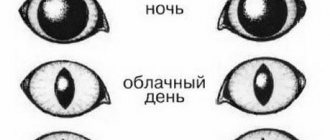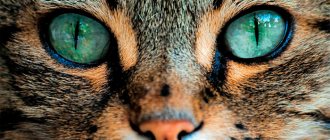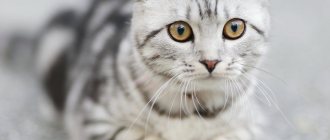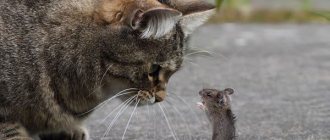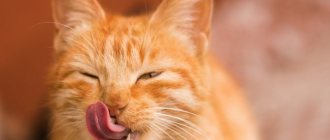Serious impairment or complete loss of visual function – blindness. It develops in pets for a number of reasons - ranging from congenital anomalies to injuries and the development of malignant neoplasms. The ophthalmological problem has characteristic symptoms and does not go unnoticed by the owner.
Many types of amaurosis (absolute loss of vision) are reversible, and with proper treatment, the animal's vision returns. Things are more complicated with congenital blindness.
Causes of vision loss
In animals, vision loss can be sudden, for example, due to trauma, mechanical damage to the eyeball, stroke, or brain damage. Blindness can also develop gradually due to inflammatory processes in the optical system of the eye (ocular neuritis, development of diabetic cataracts, degenerative processes in the retina).
Veterinarians distinguish between congenital and acquired blindness in cats. Congenital anomalies account for 5 - 10% of all cases of treatment with the disease. The main share of visual pathology is acquired blindness due to injuries, eye diseases, and systemic diseases of internal organs.
Ophthalmological veterinary practice shows that among the many reasons leading to loss of vision in a domestic cat, the most common are:
- Retinal tear
Anomalies associated with impaired development of the optical structures of the visual organs . As a rule, such defects are detected at a young age. - Increased intraocular pressure . Glaucoma, which is common in animals, usually leads to gradual loss of vision. The pet manages to adapt to decreased visual function and blindness.
- Cataract. Destructive processes in the optical system of the eye (lens) are one of the common causes of amaurosis in a cat.
- Inflammatory processes of the organs of vision. Keratitis, uveitis, and neuritis lead, as a rule, to a gradual deterioration of visual function.
- Ophthalmic neoplasms.
- Injuries and mechanical damage to the eyeball are a common cause of sudden blindness in a pet.
- Retinal atrophy as a cause of gradual loss of visual function is most often hereditary.
- Diseases, injuries, infections, neoplasms in the brain lead to the fact that the function of transmitting impulses from the organs of vision to the animal’s nervous system is disrupted or completely lost.
- Accompanying illnesses. Diabetes mellitus in domestic cats is accompanied by the development of destructive processes and often leads to complete blindness. Pathogenic microorganisms - chlamydia - can cause a shutdown of visual function.
In rare cases, the cause of visual impairment is dietary errors caused by vitamin deficiencies . Old and weakened pets are susceptible to the disease. Blindness in old age is a common occurrence among felines.
We recommend reading about glaucoma in cats. You will learn about the causes and symptoms of glaucoma, types of disease, diagnosis and treatment. Find out more about cataracts in cats here.
Problems with coordination
A lack of coordination may indicate that the animal has become blind or has become much worse in vision. In scientific circles, loss of coordination of movements is called ataxia. This phenomenon does not affect the intellectual abilities of the animal, but characterizes damage to the tissues of the nervous system.
It is very important to monitor your pet if the owner notices the animal has problems with coordination. In addition to problems with the visual organs, ataxia can occur with:
- Cerebellar injuries due to falls. In addition to impaired coordination of movements, the cat develops tremors during any movements.
- Damage to the structures of the inner ear. Vestibular ataxia in cats can be caused by otitis media or tumor processes in the inner ear.
Signs of blindness in cats
The owner can understand that a cat has lost its vision only in the event of a sudden onset of pathology. With a gradual decrease in the acuity of vision of the surrounding world, the animal’s body has time to adapt to the new situation. Hearing, smell, and whiskers come to the rescue, and it is quite difficult to understand that something is wrong with a striped pet.
Veterinary ophthalmologists advise owners to pay attention to the following clinical signs of a developing disease:
- The animal's movements in a familiar room become cautious.
- In an unfamiliar place, a cat sits in place for a long time, without exploring the space. When trying to move, he bumps into objects, his movements are uncertain and clumsy.
- The animal does not jump.
- The gait changes, becomes cautious and uncertain.
- The gaze may be cloudy, without concentrating on a bright moving object.
- With one-sided blindness, a cat turns its head more often, trying to look at an object with its healthy eye.
- The animal begins to lead an inactive lifestyle: sleeps a lot, reluctantly takes part in games.
- When playing, the cat misses and misses the “prey.”
- Stops hunting mice and birds.
- The animal becomes timid, timidity and nervousness develop.
- Constantly monitoring the space with the help of its whiskers, a cat with poor vision often breaks them off.
When keeping a pet in an apartment without access to the street, it is very difficult to notice oddities in behavior. This is due to the fact that in a familiar and familiar space, animals remember well the location of furniture and objects and, with the help of other senses, are well oriented in their own walls.
Frequent collisions with objects
Constantly bumping into objects. With a sudden loss of vision, the animal begins to collide not only with objects, but also with walls. In this regard, veterinary experts strongly do not recommend that owners of cats who have lost their vision make changes in the house.
If there is a lot of furniture in the house that has sharp corners, it is recommended to wrap them in something soft. Special film or devices are perfect for these purposes, the purpose of which is to protect furniture for small children who are just exploring the world.
Often colliding with objects, a blind animal will soon remember the route and automatically determine distances. Not all cats can remember distances and routes, so in this case they rely on their sense of touch. It is the whiskers that are very important for old and blind animals, playing the role of a kind of probe. Vibrissae allow the cat to determine at what distance an object is from the animal.
Diagnosis of the condition
If you suspect vision problems, your cat should be seen by an ophthalmologist. In a specialized institution, a veterinary specialist will conduct a series of ophthalmological diagnostics to determine the cause of blindness. First of all, the doctor will do a visual examination using lighting and magnification . At this stage, disturbances in the retina, changes in the transparency of the media, and disturbances in the optic nerve can be detected.
After a visual examination, the doctor will use an ophthalmoscope to examine the internal structures of the animal’s eyes, provided they are transparent. Some modern clinics have video ophthalmoscopy , which documents the results of a study of the intraocular structures of the eye.
The research method allows us to identify the following causes of blindness: detachment and degenerative changes in the retina, including atrophy, neuritis, optic nerve tumor, arterial hypertension. To exclude glaucoma, the animal must undergo tonometry.
Modern methods for diagnosing ophthalmological diseases include electroretinography , which allows one to study the functions of the retina. The examination is especially informative if the ophthalmoscopic picture of the fundus is normal.
If necessary, the specialist will prescribe an ultrasound examination of the eyeball . The method is used to determine the position of the lens, the presence of various formations in the anterior chamber of the eye and the vitreous body, and damage to the retina.
Magnetic resonance imaging is often used as an additional diagnostic method . The study allows us to identify the presence of neoplasms and inflammatory processes in intraocular structures, as well as obtain a visual picture of brain tissue.
For the purpose of differential diagnosis, laboratory and biochemical methods of studying blood and urine are used to exclude diabetes mellitus, chronic renal failure and other concomitant diseases.
Belova
Editor of the section “Dermatology”
Practicing veterinarian, lecturer in veterinary dermatology and allergology at the Estonian Agricultural University, diploma holder of the European College of Veterinary Dermatology
In 1995 she graduated with honors from the Estonian Academy of Agriculture with a degree in veterinary medicine. From the moment of graduation to this day, he has been a practicing veterinarian, specializing in dermatology for the last 12 years. The main patients are dogs and cats, less often horses and other animals. Trained in the best dermatological clinics under the guidance of leading specialists, for example:
- 2000–2001, dermatological clinic of Dr. D. Carlotti in Bordeaux, France.
- 2004, Dermatology Department, Pet Clinic, The Royal (Dick) School of Veterinary Studies in Edinburgh, Scotland.
- 2005, Dermatological Department of Veterinary Clinic, University of California (Davis), USA.
- 2006, 2008, Department of Dermatology, Small Animal Clinic, University of Munich. Ludwig Maximilian, Germany.
- 2007, Department of Pathology, Veterinary Faculty, University of Bern, Switzerland.
- 2010, Department of Dermatology at the Small Animal Clinic and Equine Clinic of the Veterinary Institute in Uppsala, Sweden.
- 2011, Department of Dermatology, Small Animal Veterinary Clinic, University of North Carolina (Raleigh), USA.
Since 1999, he annually takes part in international veterinary congresses, seminars and master classes. Since 2005, he has been lecturing on dermatology at the Estonian Agricultural University, teaching senior students in clinical dermatology. From 2007 to 2011 she completed a residency program at the European College of Veterinary Dermatology at the University of Zurich. Member of the European Society of Veterinary Dermatologists, member of the International Society of Veterinary Dermatopathologists, member of the Estonian Small Animal Veterinary Association. Actively participates in postgraduate education, receiving trainees from Russia and the Baltic states at the clinic, participating in conferences and master classes organized in Estonia, Latvia, Lithuania, Russia, Ukraine, Belarus, Poland, Hungary. She gave her first lectures on dermatology in 2002 in Latvia. To date, she has prepared and delivered more than 60 lectures and master classes on dermatology in Russian, English and Estonian.
In 2010, she won the Golden Scalpel award in the Lecturer of the Year category. The Estonian Veterinary Association awarded the title "Best Veterinarian 2010".
Professional interests: patients with atopic dermatitis, histopathology, clinical photography.
Happily married, has a daughter, Christina. And of course, there were pets - the family has two beagles, two cats, a horse and a hamster.
Hobbies: traveling, horse riding.
Treatment of a blind animal
Therapeutic measures when detecting loss of vision in a pet entirely and
completely depend on the cause of the pathological condition.
If the root cause of loss of visual function is hypertension, then the main efforts will be aimed at returning intraocular pressure parameters to normal levels. The animal is prescribed a salt-free diet.
In case of inflammatory processes, the pet will be prescribed a course of antibacterial and anti-inflammatory drugs for general and local use.
Treatment of concomitant diseases (diabetes mellitus, kidney disease) often leads to restoration of visual acuity. In the treatment of the disease, immunomodulatory and vitamin preparations are used.
For some types of cataracts, surgery involving artificial lens transplantation is prescribed. The intraocular lens facilitates the penetration of light into the retina and enhances vision. Ophthalmic surgery often offers a chance to restore vision in some neoplasms.
We recommend reading about conjunctivitis in cats and dogs. You will learn about the causes of the disease, classification, symptoms, diagnosis, prevention. And here is more information about why a cat’s eyes are watery.
Is there a chance for a newborn blind kitten?
Faced with an animal's blindness at a young age, the owner wonders how
a kitten will exist without such a vital sense organ.
When kept in a city apartment, there will be no problems with a blind pet, provided that certain rules are followed and boundless love for the animal.
Having gone blind early, the kitten will perfectly navigate familiar surroundings using other senses.
Of course, there can be no talk of any free walking on the street, where the animal faces many dangers. A disabled cat should only be taken for a walk on a harness under close supervision. It is also advisable not to rearrange the furniture in the room, so as not to disorient the animal.
From pets that become blind at an early age, companion cats grow up, following their owner always and everywhere. Having good hearing, blind animals actively respond to the owner's voice. A disabled cat will be happy to take part in active games. For this purpose, it is necessary to use toys with a sound signal.
Blindness in a domestic cat can occur for many reasons. In this case, acquired vision loss is most often diagnosed in veterinary practice. When blindness develops, the first thing that changes is the behavior of the animal.
An ophthalmological examination using modern diagnostic methods will not only reveal the fact of the pathological condition, but also determine the cause and treatment strategy. For domestic cats, blindness is not a death sentence and, with proper care, does not cause problems for the owner.
Description of the pathology
The cat's eye is a precise, complex and fragile instrument. Damage to any of its structural components can cause vision loss.
In medical and veterinary practice it is customary to distinguish:
- amaurosis or absolute loss of vision;
- scotoma or partial loss of visual fields;
- hemianopsia - loss of half the visual field.
Blindness can be acquired or congenital. The animal may become blind in one eye or both. There are many reasons for the development of this pathology. Moreover, if some of them are eliminated, the animal’s vision can be partially or completely restored. But there may be cases when damage to the organ of vision is irreversible and the animal remains blind for the rest of its life. It is very important to notice changes in the animal’s behavior at the earliest stages and contact a specialist. Then there is a chance that the pathological process can be reversed or slowed down.
Useful video
Watch how the blind kitten reacted and started playing with his first toy in this video:
Similar articles
- Glaucoma in cats: symptoms, primary and secondary...
A disease that leads to blindness if not sought timely help is glaucoma in cats. Read more - The cause of your pet’s blindness is cataracts in cats: what...
Causes of cataract development in cats. The visual system of the eye in pets... Due to the development of blindness, the pet becomes fearful or aggressive. Read more
- Why do cats have watery eyes, what to do and how to treat them...
The answer to the question of why a cat's eyes are running is often worms... Self-medication can lead not only to complications, but also to the pet's blindness. Read more
- Vitamin deficiency in a cat: symptoms, how it manifests itself...
The lack of carotene (provitamin A) in the diet is the cause of the development of night blindness, which is of no small importance for a cat that hunts at dusk. Read more
- Conjunctivitis in dogs and cats: symptoms and treatment
This is a common occurrence in cats and dogs. ... similar to catarrhal, only the symptoms are more pronounced and purulent in nature, and can lead to blindness. Read more
